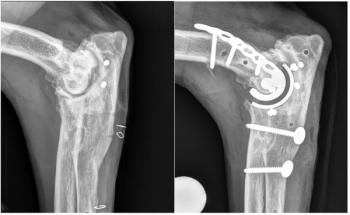
Demystifying nutrigenomics: Genes vs. genomes (Proceedings)
The information obtained by sequencing the canine and feline genomes will certainly have a major impact on the study of genetic diseases in dogs and cats.
Key points
- Nutrigenomics allows for a better understanding of the biological processes and the role of nutrients in optimizing the health of companion animals.
- Humans are a difficult model for testing the power nutrigenomics because they have a wide choice of foods and a difficult time choosing between what they should eat as opposed to what they like to eat.
- Companion animals provide an exceptional model for validating nutrigenomics' benefits and will provide insight into disease and aging in humans and in pets.
Definitions
- Nutrigenetics: The effect of genotype on nutrient absorption, metabolism, transport, or excretion
- Nutrigenomics: The effect of nutrient(s) on gene expression SNP (Single Nucleotide Polymorphism): A single nucleotide change in the DNA sequence of a gene
- Epigenetics: A stable and heritable change in gene expression that is independent of changes in DNA sequence
Genetics
The information obtained by sequencing the canine and feline genomes will certainly have a major impact on the study of genetic diseases in dogs and cats.1,2 However, although genetic diseases are a considerable problem, the vast majority of diseases affecting the health and longevity of dogs and cats are more complex. Although genetics are important, age, sex and environmental factors such as diet, activity level, and pathogen exposure play a major role in disease expression and severity. Similar to humans, advances in veterinary care and nutrition have resulted in a steady increase in the lifespan of companion animals over the past few decades. Unfortunately, the trends toward more sedentary lifestyles, greater incidence of malnutrition (most commonly overnutrition), and increased risks of complex diseases in humans are mirrored in our pets. As a result there is much interest in studying complex diseases and aging, which requires insight into the environmental influences.
Nutrigenomics
Nutrigenomics is the study of how individual nutrients or their metabolites interact with an animal's genome to regulate the structure or expression of genes. This relatively new discipline provides for a molecular understanding of how common nutritional components influence health by altering expression of an individual's genetic make-up. It is now established that nutrients may influence gene expression, including mRNA production (transcription), mRNA processing, protein production (translation) and post-translational modifications, thereby influencing the metabolic status of an animal.
Although the driving force for genome sequencing of dogs and cats has been to advance veterinary and human medical research, the understanding that progression from healthy state to diseased state often occurs through changes in gene expression has opened a new field of study in veterinary medicine. Nutrigenomics is providing an understanding of how to regulate metabolic pathways to optimize health.3 It has also opened the door to determining how ingestion of specific nutrients affect gene expression directly, or how dietary components affect systemic signals that determine overall physiologic responses. When combined with the knowledge of gene expression and biochemical differences between healthy and diseased states, a rational approach to food formulation can be used to modify expression profiles in affected animals so it will more closely reflect a healthy state.
Nutrigenomics and geriatrics
With the significant improvements that have been made in veterinary medicine and companion animal nutrition over the past few years, we have witnessed a growing population of senior dogs and cats. This has been accompanied by an increased awareness of geriatric diseases in our pets that mirrors many of the challenges faced by the aging human population. A nutrigenomic approach can be applied to understanding the aging process in companion animals. Healthy adult and senior animals given the same foods can be studied to identify the gene expression and biochemical differences characteristic of the aging process. Foods for senior animals can then be rationally designed and evaluated for their ability to modify gene expression profiles in animals to more closely reflect those found in healthy adult animals, which has the potential to improve health and quality of life.
Nutrigenomics and obesity
The relationship of obesity to other diseases is complicated and only recently is being recognized as a key factor affecting overall health. New research tools such as genomics have enabled scientists to shed some light on the underlying mechanisms which link obesity with other diseases. By performing microarray analysis on lean and obese adipose tissue and lymphocyte samples, scientists have begun to understand the processes behind obesity and, importantly, how obesity links to other diseases.
When comparing lean vs obese adipose tissue, the gene expression of obese adipocytes showed a down regulation of PPAR-gamma, uncoupling protein-2, carnitine O-palmitoyltransferase 1 A and acyl-CoA synthetase. When functioning properly these genes are important in the beta-oxidation of fatty acids. The down-regulation of these genes may explain why obese animals are fat storing instead of fat burning. In addition, the obese adipose tissue also had down-regulation of genes associated with glucose metabolism. Down-regulation of pyruvate dehydrogenase kinase-4 and glucose-6-phosphatase may be a potential link between diabetes and obesity.
Obesity is not just a weight issue. The biochemical changes occurring with obesity result in an increased susceptibility to other diseases. Genomics may provide valuable insights into the underlying mechanisms which link obesity with other diseases. The biochemical changes which occur in the adipocyte influence the adipokines released which ultimately will affect the body systemically. These changes can be quantitated by studying the genomics of lymphocytes and adipose tissue, and by measuring circulating adipokines. Weight loss appears to reverse many of the changes that occur with obesity.
Nutrigenomics and osteoarthritis
Aggrecanase is a key enzyme in the destruction of aggrecans and well-recognized in the development of osteoarthritis (Karsenty, 2005). Unpublished data (Hill's Pet Nutrition) has shown that N-3 fatty acids down-regulate the expression of aggrecanase in cartilage. Dogs with radiographic osteoarthritis and clinical signs exhibited improved mobility and a significant increase in vertical peak force when fed a food with high levels of N-3 fatty acids. Budsberg and Bartges (2006) report on unpublished clinical trials using a food high in omega-3 fatty acids. In these trials, dogs eating foods with higher omega-3 fatty acids exhibited improved ground reaction forces and had fewer radiographic signs of osteoarthritis compared to dogs eating a control food, although one trial tested a food that was high in antioxidants and contained glucosamine as well as omega-3 fatty acids.
Nutrigenomics and development
Puppy growth and nutrition
The role of nutrition in alleviating developmental orthopedic disease in dogs is well established. Classic studies feeding dogs imbalanced diets, typically deficient in calcium, phosphorus, or vitamin D3, was the main risk factor predisposing for skeletal diseases like secondary hyperparathyroidism with subsequent development of osteodystrophia fibrosa5. In large breed dogs, research indicates that rate of growth, specific nutrients, food consumption, and feeding methods influence the incidence of DOD. Nutrient excesses, such as calcium and energy, and rapid growth related to overfeeding, imbalanced nutrient allocation, and excess energy intake are known risk factors. Studies have demonstrated beneficial effects of limiting food intake, calcium and phosphorous on the expression of skeletal disease.4,5
Neurologic function may also be influenced by nutrition, with the ideal parameters being an empirical issue as previously stated. In puppies, supplementation of growth foods with DHA and fed to the bitch during gestation and lactation has been reported to improve trainability, problem solving tasks, and electroretinogram activity.6-9
Kitten Growth and Nutrition
The effect of amino acids, calcium:phosphorus ratio, vitamins and other minerals on musculoskeletal growth in kittens is well documented2. Supplementation of gestation/lactation/growth foods with DHA and fed to Queens during gestation and lactation improved electroretinogram activity and accumulation of DHA within the brain of kittens.10,11 Kittens from queens fed a protein restricted food during gestation and lactation had impaired ability to perform home-orientation tasks which may have been attributable to either locomotor or neurologic deficits14. However, information on effects of nutrition on neurocognitive development in the weaned kitten is minimal.
Summary
The intricate interaction between nutrients, environment, and physiologic response is an evolving discipline. The process of understanding systems in dogs and cats under nutritional and environmental control, as well as the interactions between these controls, is just beginning and holds promise for attainment of new definitions of optimal nutrition.
References
1. Switonski M, Szczerbal I, Nowacka J. The dog genome map and its use in mammalian comparative genomics. J Appl Genet 2004; 45:195–214
2 O'Brien SJ, Johnson W, Driscoll C, et al. State of cat genomics. Trends in Genetics 2008; 24(6): 268-279.
3 Swanson KS, Schook LB, Fahey GC. Nutritional genomics: Implications for companion animals. J Nutr 2003;133:3003-3040.
4 Kasström J. Nutrition, weight gain and development of hip dysplasia. Acta Radiol Suppl 1975; 344:135-179.
5 Kealy RD, Olsson SE, Monti KL, et al. Effects of limited food consumption on the incidence of hip dyplasia in growing dogs. J Am Vet Med Assoc 1992; 210:857-863.
6 Heinemann KM, Waldron MK, Bigley KE, et al. Long-chain (n-3) polyunsaturated fatty acids are more efficient than alpha-linolenic acid in improving electroretinogram responses of puppies exposed during gestation, lactation, and weaning. J Nutr. 2005:135(8);1960-6.
7 Heinemann KM, Bauer JE. Docosahexaenoic acid and neurologic development in animals. J Am Vet Med Assoc. 2006:228;700-705
8 Kelley RL, Lepine AJ, Burr JR, et al. Effect of dietary fish oil on puppy trainability (abstr) Preconf Workshop 6th Int Soc Study Fatty acids Lipids Cong 2004;51
9 Reynolds AJ, Waldron MK, Wilsson E, et al. The effect of long-chain PUFA supplementation on mental stability, problem solving ability, and learned pattern retention in young growing dogs (abstr) In: Proceedings, Nestle Purina Nutrition Forum 2005;Poster 19.
10 Pawlosky R, Barnes A, Salem N Jr. Essential fatty acid metabolism in the feline: relationship between liver and brain production of long-chain polyunsaturated fatty acids. J Lipid Res. 1994;35(11):2032-40.
11 Pawolsky RJ, Denkins Y, Ward G et al. Retinal and brain accretion of long-chain polyunsaturated fatty acids in developing felines: the effects of corn oil-based maternal diets. Am J Clin Nutr 1997;65(2):465-472.
Newsletter
From exam room tips to practice management insights, get trusted veterinary news delivered straight to your inbox—subscribe to dvm360.






